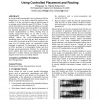Free Online Productivity Tools
i2Speak
i2Symbol
i2OCR
iTex2Img
iWeb2Print
iWeb2Shot
i2Type
iPdf2Split
iPdf2Merge
i2Bopomofo
i2Arabic
i2Style
i2Image
i2PDF
iLatex2Rtf
Sci2ools
CODES
2007
IEEE
2007
IEEE
Secure FPGA circuits using controlled placement and routing
In current Field-Programmable-Logic Architecture (FPGA) design flows, it is very hard to control the routing of submodules. It is thus very hard to make an identical copy of an existing circuit within the same FPGA fabric. We have solved this problem in a way that still enables us to modify the logic function of the copied sub-module. Our technique has important applications in the design of side-channel resistant implementations in FPGA. Starting from an existing single-ended design, we are able to create a complementary circuit. The resulting overall circuit strongly reduces the power-consumption-dependent information leaks. We show that the direct mapping of a secure ASIC circuit-style in an FPGA does not preserve the same level of security, unless our symmetrical routing technique is employed. We demonstrate our approach on an FPGA prototype of a cryptographic design, and show through power-measurements followed by side-channel power analysis that secure logic implemented with our...
CODES 2007 | FPGA | FPGA Fabric | Hardware-Software Codesign | Side-channel Resistant Implementations |
| Added | 02 Jun 2010 |
| Updated | 02 Jun 2010 |
| Type | Conference |
| Year | 2007 |
| Where | CODES |
| Authors | Pengyuan Yu, Patrick Schaumont |
Comments (0)

